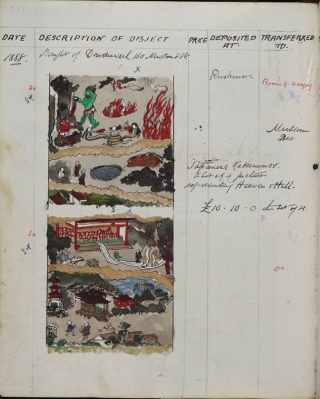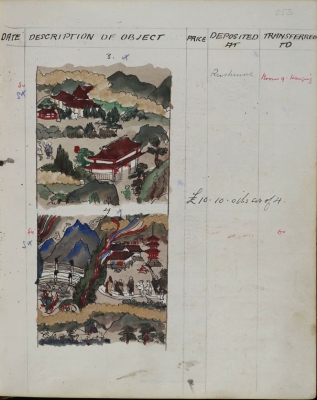S&SWM PR papers L557a

Bought of Dowdeswell, 160 New Bond St. Japanese Kakemonos a Set of 4 pictures representing Heaven & Hell] £10.10.0 the set of 4 [Drawing]
It is unclear why this description by Sparks, who presumably sold the picture to Pitt-Rivers on behalf of Dowdeswell, is described in the catalogue as 'a set of four' and depicted as such. It may have been a cut-down scroll? Kakemono means a wall hanging, see here for more general information
[Containing description of Japanese kakemono of Heaven & Hell]
L557a
"St Heliers" | West Bank, | Stamford Hill, N.
Dear Sir
According to your wishes I herewith beg to enclose you a few descriptive remarks respecting your picture, [sic, there seem to be 4] which information has been gleaned by myself both from the natives themselves abroad and from several books I have from time to time consulted written by good authorities.
Any further information I can at any time impart I shall be pleased to give you if you will kindly write or call and ask me.
For the present any letters addressed to me at 160 New Bond St will be sure to reach me at once.
I am dear Sir
Yours faithfully
John Sparks
Gen'l Pitt Rivers
Dowdeswell & Dowdeswells | Fine Art Publishers | 160 New Bond Street | London W. Oct 22 1888 | Telephone No 3779
Re. "Heaven & Hell"
The lower portion of the picture (separated by the Golden Cloud, the cloud being used by Japanese Artists of that period instead of mere formal lines to denote that the subjects on either side were a distinct or separate picture in themselves) [sic, punctuation] represents the ordinary life of the Japanese on Earth.
The animal running in the foreground pierced by an arrow depicts a sport that was for many years practised in Japan, namely the hunting of dogs who were kept expressly for that purpose, the idea of thus depicting this pastime, is that according to the rules and teachings of Buddhism, cruelty to animals was one of the greatest of sins and anyone guilty of the crime received most condign punishment. In many instances the victim having to return to Earth after his death, in the form of the animal he tortured during his lifetime, and receiving tenfold the amount of pain he himself had inflicted.
The river on the right is supposed to represent the boundary twixt Life and Death, having crossed wich the spirit of the departed one is led by the attendant priests (as shown in the picture) before a Tribunal consisting of a number of Judges.
Over the head of the Probationer you will observe a species of canopy is borne, this is the ordinary covering for a dead body in the Japanese funerals and is given here by the artist to indicate that the figure over which it is being carried is that of a person but very recently defunct.
On the left of the Tribunal is a hideous old hag who is apparently mutilating a victim, this is the Sodzu-gawa no Uba, or the Woman of the Three paths whose avocation is to receive the earthly clothing from each new arrival and then according to the fiat of the Tribunal dispatch them on One of the Three Paths namely either to Nirvana (Paradise), Jigoku (Hell) or back again in some other form to Earth again.
In Hell itself are depicted the usual forms of punishment; amongst them may be noted the Liar & Slanderer who is having his tongue torn out by the roots. The lustful sinner who is always seeing a gay courtesan close before him and yet when he reaches forward to seize upon her he falls and lacerates his body on the spikes that lay around.
The Unfaithful Women are being slowly drowned in a pool of blood (drawn from themselves during their lifetime,)(periodically).
The "Gaki', or, men who in life have been gluttonous, are here depicted as wretched starvelings craving for food which occasionally is tendered to them in tempting form by Demons, when immediately upon their placing it to their lips it turns into fire and burns their mouths etc.
The victim being held up by the hair of his head in the clutches of a large Demon is one who having denied his crime is being held up before the Magic Mirror whereupon he at once sees reflected, himself committing the crime he has just denied which in this instance was the setting fire to a Buddhistic Temple.
The figure in the centre at whose feet children are seen, is one of the favourite deities or saints of the Japanese, viz the god "Jizo" who is supposed to be ever on the watch to protect little children and who also at certain periods himself undergoes the tortures of Hell in order that those under sentence may be respited
The other priestly figures surrounding the altar area Saints residing in Purgatory and [insert] who [end insert] are incessantly offering up prayers and penances, thus mitigating the severer sentences passed on the most unfortunate.
To the right of the whole picture is given a description of the hard wearisome journey made by the true Buddhist, together with the many devotions and purifications to be performed ere he can hope to reach "Nirvana" which is depicted on the extreme right by a representation of the Bhuddist [sic] Trinity namely Buddha & his two sons surrounded by the Heavenly choir.
"Nirvana" being protected by a sea of a Dragons [sic] who prevent any one entering save through the medium of the Goddess of Mercy whose form may be seen at the very top of the High mountains as if urging the Toiler to struggle on his upward path.
Transcribed by AP May 2011 as part of the Rethinking Pitt-Rivers project.



